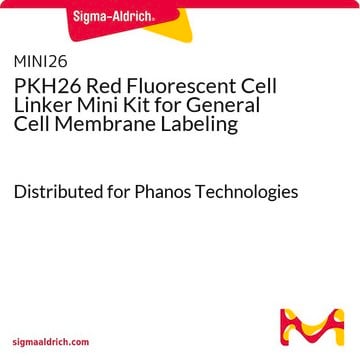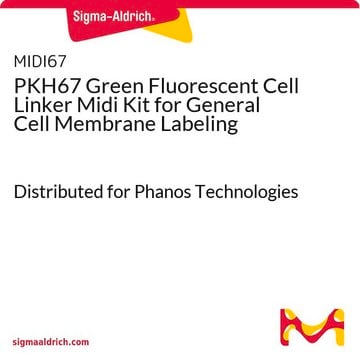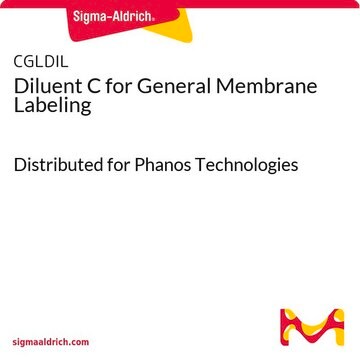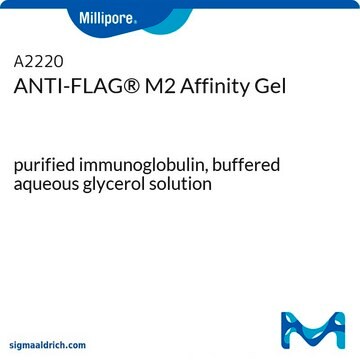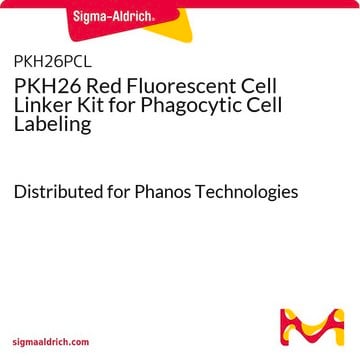MINI67
PKH67 Green Fluorescent Cell Linker Mini Kit for General Cell Membrane Labeling
Distributed for Phanos Technologies
Synonym(s):
Green PKH membrane mini labeling kit
Sign Into View Organizational & Contract Pricing
All Photos(1)
About This Item
UNSPSC Code:
12352207
NACRES:
NA.32
Recommended Products
packaging
pkg of 1 kit
Quality Level
manufacturer/tradename
Distributed for Phanos Technologies
storage condition
protect from light
technique(s)
flow cytometry: suitable
fluorescence
λex 490 nm; λem 502 nm (PKH67 dye)
application(s)
cell analysis
detection
detection method
fluorometric
shipped in
ambient
storage temp.
room temp
General description
PKH67 kit is for general cell membrane labeling. It has a longer aliphatic carbon tail than PKH1 and PKH2, two other green dyes previously described for in vitro and in vivo cell tracking. Based on the longer tail length, in-house studies have consistently shown reduced cell-cell transfer for PKH67 as compared to PKH2.
Slow loss of fluorescence has been observed in in vivo studies using PKH1 and PKH2. PKH67 may exhibit similar properties since this behavior appears to be characteristic of green cell linker dyes, but not red cell linker dyes. Correlation of in vitro cell membrane retention with in vivo fluorescence half life in non-dividing cells predicts an in vivo fluorescence half life of 10-12 days for PKH67. Other green cell linker dyes with similar half lives have been used to monitor in vivo lymphocyte and macrophage trafficking over periods of 1-2 months, suggesting that PKH67 will also be useful for in vivo tracking studies of moderate length.
Slow loss of fluorescence has been observed in in vivo studies using PKH1 and PKH2. PKH67 may exhibit similar properties since this behavior appears to be characteristic of green cell linker dyes, but not red cell linker dyes. Correlation of in vitro cell membrane retention with in vivo fluorescence half life in non-dividing cells predicts an in vivo fluorescence half life of 10-12 days for PKH67. Other green cell linker dyes with similar half lives have been used to monitor in vivo lymphocyte and macrophage trafficking over periods of 1-2 months, suggesting that PKH67 will also be useful for in vivo tracking studies of moderate length.
Application
PKH67 green fluorescent cell linker mini kit for general cell membrane labeling has been used to stain:
- exosomes
- pericytes
- UT-7/TPO cells
This kit is for general cell membrane labeling. Slow loss of fluorescence has been observed in in vivo studies using PKH1 and PKH2. PKH67 may exhibit similar properties since this behavior appears to be characteristic of green cell linker dyes, but not red cell linker dyes.
Linkage
For additional technical details on PKH and CellVue® Fluorescent Cell Linker Dyes including an extensive bibliography, please visit here.
Legal Information
Distributed for Phanos Technologies, Inc.
CellVue is a registered trademark of Phanos Technologies
Kit Components Only
Product No.
Description
- Diluent C 10 mL
- PKH67 Cell Linker in ethanol 0.1 mL
Signal Word
Danger
Hazard Statements
Precautionary Statements
Hazard Classifications
Eye Irrit. 2 - Flam. Liq. 2
Storage Class Code
3 - Flammable liquids
Flash Point(F)
55.4 °F - closed cup
Flash Point(C)
13 °C - closed cup
Choose from one of the most recent versions:
Already Own This Product?
Find documentation for the products that you have recently purchased in the Document Library.
Customers Also Viewed
A microfluidic study of megakaryocytes membrane transport properties to water and dimethyl sulfoxide at suprazero and subzero temperatures
Tseng HY, et al.
Biopreservation and Biobanking, 9(4), 355-362 (2011)
Exosomal MALAT1 derived from oxidized low-density lipoprotein-treated endothelial cells promotes M2 macrophage polarization
Huang C, et al.
Molecular Medicine Reports, 18(1), 509-515 (2018)
Haiyang Xu et al.
Stem cell research & therapy, 10(1), 381-381 (2019-12-18)
Mesenchymal stem cells (MSCs) play a significant role in cancer initiation and metastasis, sometimes by releasing exosomes that mediate cell communication by delivering microRNAs (miRNAs). This study aimed to investigate the effects of exosomal miR-133b derived from MSCs on glioma
Yuan Yang et al.
Experimental and therapeutic medicine, 20(6), 257-257 (2020-11-18)
Mesenchymal stem cell (MSC) infusion has become a novel therapeutic strategy for complex autoimmune diseases; however, few detailed studies have been performed to investigate the benefit and mechanism of MSC treatment on systemic sclerosis (SSc). The present study aimed to
Simone Moertl et al.
International journal of molecular sciences, 21(7) (2020-04-02)
Normal tissue toxicity is a dose-limiting factor in radiation therapy. Therefore, a detailed understanding of the normal tissue response to radiation is necessary to predict the risk of normal tissue toxicity and to development strategies for tissue protection. One component
Our team of scientists has experience in all areas of research including Life Science, Material Science, Chemical Synthesis, Chromatography, Analytical and many others.
Contact Technical Service

